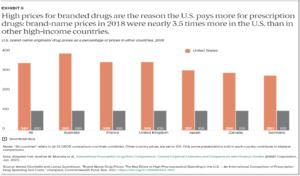Causes: Patent Times, Lobbying, or a Multifaceted issue?
Dr. Vincent Rajkumar, an MD researching underneath the Mayo Clinic with experience working with pharmaceutical drugs and co-chair of the American Society of Hematology, suggests four reasons for status quo high prescription drug costs: the lack of alternative medications for conditions leading to the formation of monopolies, the dependence on prescriptions for maintenance of life leading to the manipulation of prices that people will inevitably be “willing to pay”, high development prices for prescription drugs, and the lobbying power of pharmaceutical companies, amounting to 220 billion dollars in one year in the US (Rajkumar). Monopolies are especially conducive to rising drug prices since drug companies with a monopoly can boost prices without worrying about a competitor with lower prescription drug prices (Rajkumar). Other authors agree on these causes; Dr. Aaron Kesselheim, professor at Harvard, concurs that “the most important factor [allowing] manufacturers to set high drug prices is market exclusivity, protected by monopoly rights awarded upon FDA approval” (Kesselheim 1). The FDA provides patents for up to 20 years for certain drugs, inhibiting competition from generic biosimilars, which are drugs that perform the same function yet are under a different brand name and composition (Kesselheim 4).
Truly a multifaceted issue!




